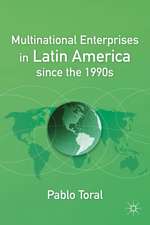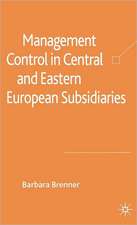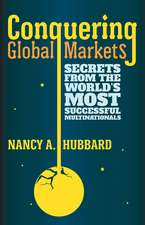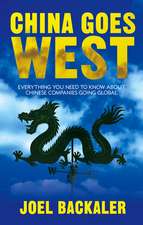Managing Pharmaceuticals in International Health
Autor Stuart Anderson, Reinhard Huss, Rob Summers, Karin Wiedenmayeren Limba Engleză Paperback – 25 iun 2004
Preț: 379.16 lei
Preț vechi: 399.12 lei
-5% Nou
Puncte Express: 569
Preț estimativ în valută:
72.55€ • 75.75$ • 60.05£
72.55€ • 75.75$ • 60.05£
Carte tipărită la comandă
Livrare economică 04-18 aprilie
Preluare comenzi: 021 569.72.76
Specificații
ISBN-13: 9783764366018
ISBN-10: 376436601X
Pagini: 280
Ilustrații: XIV, 232 p. 103 illus.
Greutate: 0.68 kg
Ediția:2004
Editura: Birkhäuser Basel
Colecția Birkhäuser
Locul publicării:Basel, Switzerland
ISBN-10: 376436601X
Pagini: 280
Ilustrații: XIV, 232 p. 103 illus.
Greutate: 0.68 kg
Ediția:2004
Editura: Birkhäuser Basel
Colecția Birkhäuser
Locul publicării:Basel, Switzerland
Public țintă
ResearchCuprins
1 Issues in the Management of Pharmaceuticals in International Health.- 1.1 Introduction.- 1.2 Pharmaceuticals, medicines and drugs.- 1.3 International health.- 1.4 The emergence of medicines.- 1.5 Global inequity and the medicines life cycle.- 1.6 The study of pharmaceuticals in international health.- 1.7 Approaches to managing pharmaceuticals.- 1.8 Layout of the book.- 1.9 Conclusion.- 2 Access and Availability of Pharmaceuticals in International Health.- 2.1 Introduction.- 2.2 Access to essential medicines.- 2.3 Neglected diseases.- 2.4 Strategies for developing medicines and ensuring access.- 2.5 Conclusion.- 3 Assessing the Pharmaceutical Needs of Patients and Populations.- 3.1 Introduction.- 3.2 Public health pharmacology.- 3.3 Incidence of disease.- 3.4 Needs and priorities for medicines.- 3.5 Culture and the use of medicines.- 3.6 Patients as consumers.- 3.7 Compliance, adherence and concordance.- 3.8 Empowerment.- 3.9 Conclusion.- 4 The Role of Health Professionals.- 4.1 Introduction.- 4.2 Classifying health professionals.- 4.3 Health professionals and medicine responsibilities.- 4.4 The role of the doctor.- 4.5 The role of the pharmacist.- 4.6 Traditional healers.- 4.7 Integrating traditional medicine and Western medicine.- 4.8 Conclusion.- 5 The Role of the Pharmaceutical Industry.- 5.1 Introduction.- 5.2 The origins and development of the pharmaceutical industry.- 5.3 Structure of the industry today.- 5.4 Pharmaceutical company partners.- 5.5 The activities of the industry.- 5.6 Pharmaceutical markets.- 5.7 The pharmaceutical industry and international health.- 5.8 Conclusion.- 6 The Role of Governments.- 6.1 Introduction.- 6.2 The development of national drug policies.- 6.3 The drug supply process.- 6.4 Health systems that support drug supply.- 6.5 Pharmaceutical legislation and regulation.- 6.6 Research, monitoring and evaluation.- 6.7 Conclusion.- 7 The Role of the European Union, National Assistance Agencies and NGOs.- 7.1 Introduction.- 7.2 The European Union.- 7.3 The national aid agencies.- 7.4 International and national NGOs.- 7.5 Some non-governmental organizations.- 7.6 Equitable pharmaceutical supply and distribution.- 7.7 Conclusion.- 8 The Role of International Organizations.- 8.1 Introduction.- 8.2 WHO and other UN organizations.- 8.3 Industry organizations.- 8.4 Other organizations.- 8.5 Essential drugs.- 8.6 Pharmaceutical procurement.- 8.7 International agreements and intellectual property rights.- 8.8 Case study-HIV/AIDS and antiretroviral treatment in South Africa.- 8.9 Conclusion.- 9 Rational Use of Medicines.- 9.1 Introduction.- 9.2 Consequences of non-rational medicine use.- 9.3 Medicine use behaviour.- 9.4 Investigating medicine use problems.- 9.5 Medicine use interventions.- 9.6 Effectiveness of interventions.- 9.7 Conclusion.- 10 Medicine Quality, Adverse Reactions and Antimicrobial Resistance.- 10.1 Introduction.- 10.2 Quality of medicines.- 10.3 Counterfeit medicines.- 10.4 Adverse drug reactions.- 10.5 Antimicrobial resistance.- 10.6 Conclusion.- 11 Managing Medicines Information.- 11.1 Introduction.- 11.2 The users of medicine information.- 11.3 Sources of information.- 11.4 The quality of medicines information.- 11.5 The assessment of information.- 11.6 Classification systems.- 11.7 Conclusion.- 12 Investigating the Use of Medicines.- 12.1 Introduction.- 12.2 Drug utilization studies.- 12.3 Pharmacoeconomics.- 12.4 Pharmacovigilance.- 12.5 Pharmacoepidemiology.- 12.6 Health systems and policy studies.- 12.7 Conclusion.- 13 Trends and Developments.- 13.1 Introduction.- 13.2 Trends in the use ofherbal remedies.- 13.3 The contribution of pharmacogenetics and pharmacogenomics.- 13.4 The changing role of the internet.- 13.5 Changes in the health care workforce.- 13.6 Conclusion.- 14 Policy Initiatives and their Implications.- 14.1 Introduction.- 14.2 The role of public-private partnerships.- 14.3 The Global Fund and other initiatives.- 14.4 Global procurement of medicines.- 14.5 AIDS drugs post Doha.- 14.6 Conclusion.- Selected Websites and Webportals.
Caracteristici
A new perspective on the politics of drug supply Indispensable for students of public health












